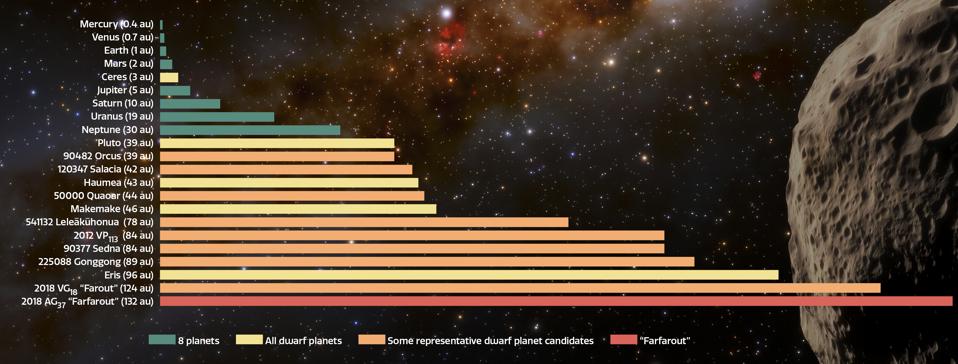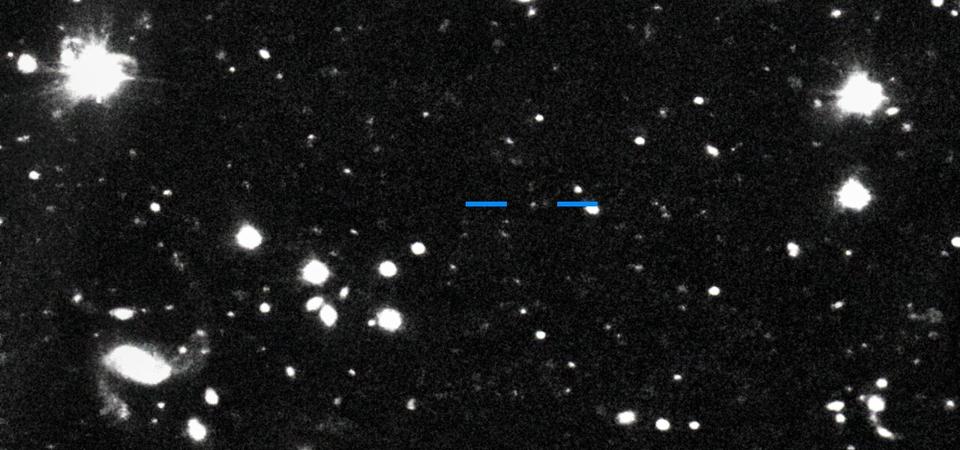You Need To Re-Learn Our Solar System. Welcome To ‘Farfarout,’ Now Officially Its Most Distant World

This illustration imagines what the distant object nicknamed “Farfarout” might look like in the … [+]
NOIRLab/NSF/AURA/J. da Silva
Two years after being discovered and nick-named by a team of astronomers, a planetoid almost four times farther from the Sun than Pluto has been officially confirmed.
The confirmation of “Farfarout” by the Minor Planet Center comes in the wake of its orbit being calculated for the first time. It’s also now been given the less descriptive name of “2018 AG37.”
It will be given an official name after its orbit is better determined over the next few years.
What is Farfarout?
It’s a very faint and probably icy object estimated to be around 250 miles/400 km in diameter. That makes it a “planetoid”— a very small “dwarf planet.”

Solar system distances to scale, showing the newly discovered planetoid, nicknamed “Farfarout,” … [+]
Roberto Molar Candanosa, Scott S. Sheppard (Carnegie Institution for Science) and Brooks Bays (University of Hawai?i)
Where is Farfarout?
It’s currently 132 astronomical units (au) from the Sun—1 au being the distance between the Earth and Sun, which is the unit of measurement used by astronomers to describe the Solar System. The now confirmed distance of 2018 AG37 makes in farther out than the previous record holder 2018 VG18, also found by the same team. That was nick-named simply “Farout.”
How long is a year on Farfarout?
A year is the time it takes for an object to orbit the Sun. On Farfarout its year lasts for about a thousand Earth-years. “A single orbit of Farfarout around the Sun takes a millennium,” said David Tholen of UH Mānoa and a member of the research team that found Farfarout.
MORE FOR YOU
Here’s a chart that shows you every confirmed object in the Solar System and its distance from the Sun:

This illustration depicts the most distant object yet found in our Solar System, nicknamed … [+]
NOIRLab/NSF/AURA/J. da Silva
How far beyond Pluto is Farfarout?
Much further … usually. Pluto is 34 au from the Sun while Neptune is 27 au. While Farfarout reaches a whopping 175 au from the Sun, its hugely elongated orbit takes it inside the orbit of Neptune when it is closest to the Sun. That bizarre orbit is almost certainly caused by gravitational interactions with Neptune, which will help astronomers understand how Neptune formed and evolved.
Who found Farfarout?
Since Farfarout moves very slowly across the sky it took several years of observations to precisely determine its trajectory and confirm its orbit.
It was initially discovered by the Subaru 8-meter telescope atop Maunakea in Hawaii and also studied by the Gemini North and Magellan telescopes.
The research team includes University of Hawaiʻi Mānoa’s David Tholen, Scott S. Sheppard of the Carnegie Institution for Science and Chad Trujillo of Northern Arizona University, who have an ongoing survey to map the outer solar system beyond Pluto.

This discovery image of Farfarout (2018 AG37) was taken with the Subaru Telescope on the night of 16 … [+]
S. Sheppard
Are there more planetoids out there?
Almost certainly. “Farfarout is just the tip of the iceberg of solar system objects in the very distant solar system,” said Scott S. Sheppard of the Carnegie Institution for Science, a member of the team. “Even though some of these distant objects are quite large, being dwarf planet in size, they are very faint because of their extreme distances from the Sun.”
He added that new digital cameras on very large telescopes has made it possible to discover very distant objects like Farfarout.
Wishing you clear skies and wide eyes.
